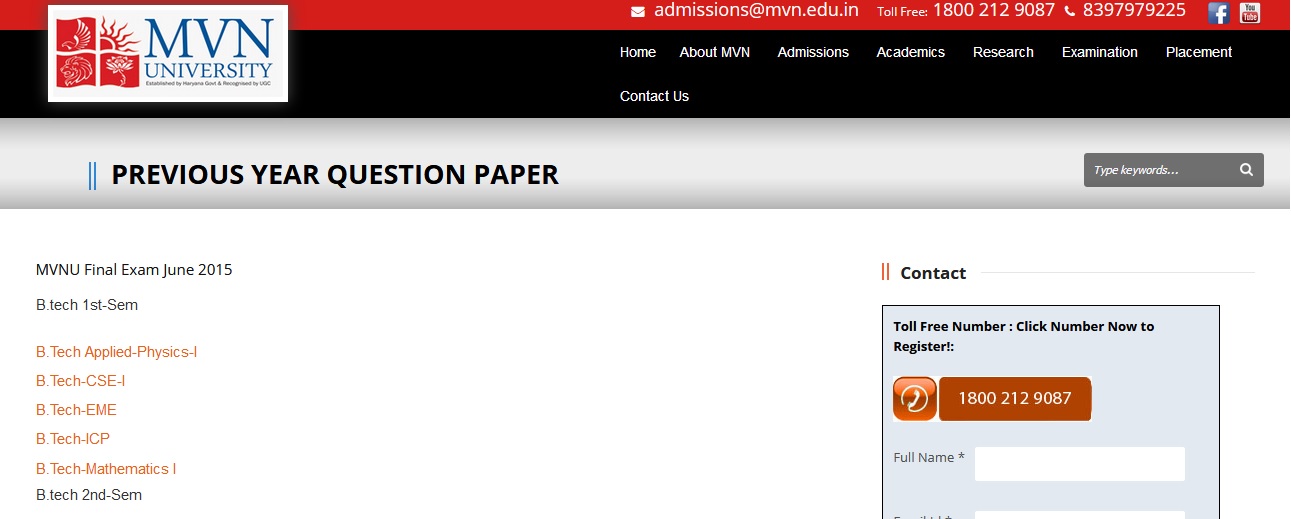MVN CAL110 Data Base Management System BBA Previous Year Question Paper
Name of the College : MVN University
Subject Code/Name : CAL-110-Data Base Management System
Year : Jan.2014
Degree : BBA
Sem : II
Website : mvn.edu.in
Document Type : Previous Year Question Paper
Download Model Question Paper : https://www.pdfquestion.in/uploads/mvn.edu.in/3126-DBMS-2nd-Sem.pdf
MVN Data Base Management System Previous Question Paper
Time Allowed: 03 hours.
Maximum Marks: 100
Related / Similar Question Paper :
MVN University Engineering Geology MBA Model Question PaperMVN Communication Skills & Personality Development BBA Question Paper
Instructions
** Before answering the question paper the candidate should ensure that they have been supplied the correct question paper.
** Complaints in this regard, if any, shall not be entertained after the examination.
January 2014
Note: All questions carry equal marks. Ques. No. 1 is Compulsory and attempt two questions from each section.
1. Write a short note on (20)
(a)Data dictionary
(b)E-R diagram
(c)Functional and Multivalued and Transitive dependencies
(d)Recovery

SECTION – A :
2(a) Discuss the architecture of Database System. (10)
(b) Differentiate between: (5*2=10)
(i) File System and Database System
(ii) Physical and Logical data independence
3. Explain with examples of following data models : (20)
(a) Hierarchical data model
(b) Network data model
(c) Relational data model
4. What do you mean by RDBMS?Explain.What are the Codd’s 12 Rules for a RDBMS to be accepted as a full fledged RDBMS? (20)
SECTION- B :
5. Explain the concept of Normalization .Also explain 1st to 3rd normal forms and BCNF with suitable examples . (20)
6(a).Explain SQL. What are the main features of SQL? Also write the SQL command syntax for Create , Insert and viewing all records using suitable examples. (10)
(b) Write a note on Concurrency control in database. (10)
7(a) Explain by giving suitable examples, the working of set operators i.e. Union, Intersect, and Except.
(b) How are the aggregate operators deals with null values?
(c) What is referential integrity constraint? Explain.
(d) Differentiate between Normalization and Denormalization. (5*4=20)
June2013
Data Base Management System
Subject Code: CAL -110
Time Allowed: 03 hours.
Maximum Marks: 100
Note :
** Before answering the question paper the candidate should ensure that they have been supplied the correct question paper.
** Complaints in this regard, if any, shall not be entertained after the examination.
** Attempt any five questions and all questions carry equal marks.
Section-A
1 a) Define data, database, DBMS, record, file and field. What are the advantages and disadvantages offered by DBMS as compared to file system (15)
b) What are the responsibilities /functions of Database Administrator (DBA) (5)
2 a) Discuss Hierarchical and Network data model: (2*5=10)
b)Define primary, secondary, candidates, alternate and Foreignkey using example (10)
3. Write the note on following: (20)
(i) DBMS vs RDBMS
(ii) Types of Keys
(iii) Concurrency control
Section B :
4. Explain the concept of Normalization and BCNF. Also explain fully functional dependency and transitive dependency using suitable examples (20)
5a) What is SQL? Explain its use and its features. Also show how will you view all the data of the table using SQL query with example. (10)
b) Discuss the architecture of database system. Explain in detail. (10)
6. Write a short note on following: (20)
(a) E-R diagram
(b)Different types of functional dependencies
(c) Data dictionary
(d) Data Independence
June-2014
Database Management System
Subject Code: CAL-204
Time Allowed: 03 hours.
Maximum Marks: 100
Before answering the question paper the candidate should ensure that they have been supplied the correct question paper.
Complaints in this regard, if any, shall not be entertained after the examination.
Note: All questions carry equal marks. Ques. No. 1 is Compulsory and attempt two questions from each section.
1a. Differentiate between logical data independence and physical data independence.
b. Discuss BCNF
c. Explain the problems which may occur if concurrency control is not implemented in databases.
d. List the roles and responsibilities of Database Administrators.
e. Differentiate between primary and secondary index. (5*4=20)
SECTION-A
2(a) Explain three schema architecture of DBMS. Why do we require mapping between the three.
(b) List and explain advantages of DBMS over traditional file system. (2*10=20)
3(a) Explain entity integrity and referential integrity constraints. Discuss their importance in Database design.
(b) Write algorithm for finding closure of a set of FDs. Explain with example. (2*10=20)
4. Consider the following schema:
Sailors (Sid, Sname, Rating, Age)
Boat (Bid, Bname, Color)
Reserve( Sid, bid, day)
Write the following SQL queries and their relational algebra equivalent
a) Find the name of sailors who have reserved boat 103.
b) Find the name of sailors who have reserved a red boat.
c) Find the color of boats reserved by “Rama”.
d) Find the name of sailors who have reserved at least a boat.
e) Find the name of sailors who have reserved a red or green
SECTION-B
5(a) Discuss time stamp ordering protocol for concurrency control. Explain basic time stamp ordering algorithm.
(b) Define a transaction. Explain its properties and life cycle. (2*10=20)
6(a) Explain structure of index sequential files.
(b) Explain B-trees index file. How data is stored in it? (2*10=20)
7(a) Consider the relational schema and set of FD. R(A,B,C,D,E,F,G,H,I,J) , { AB->C,A->DE,B->F, F->GH,D->IJ}. Find the key of the relation. And decompose the relation into 2NF & 3NF.
(b) List different types of database users and explain their roles. (2*10=20)